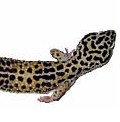Leopard gecko or eublepharis macularius are part of the lizard family. These breeds have originated from the Middle East and Asian Region particularly in Afghanistan, India and Pakistan. The leopard geckos' natural environment is dry and rocky like the dessert. They prosper and usually underground.
Leopard Gecko's Physical Features.The leopard gecko's head is usually triangular shape and its body is equipped with a huge tail use in storing fats. The gecko's skin is naturally patterned and ornate as it serves as a camouflage from its natural enemies. The lizard's skin is also robust to protect them from the roughness of the sand and rock surface they usually travel. One may notice that the lizard's back or upper side of the body projects a rough exterior while the ventral side looks smooth, translucent and the skins are thin. As they grow and/or ages the skins sheds which then gives off a more vibrant color.
These reptiles have toes, eyelids and are usually heavily bodied. They are labeled as a nocturnal or night species and are equipped with natural vertical elliptical pupils used as a night vision. Leopard geckos in general small in sizes and averages at nine inches but there are big leopard gecko sightings are they known to have reached up to twelve inches in length.
Leopard geckos can also survive and exist as much as fifteen to twenty-two years. This lizard weighs about three grams when young and weights at about forty-five to sixty-five grams as adult. Lizards that where bred and grew up in the wild tend to have dull and darker colors as compared to captive-bred geckos and are cared for as family pets which tend to have more skin color and pattern assortment.
Geckos have unique and distinct characteristics that are evident in its tail. The tail has vertebrae or vertebral column that contains fracture planes located near the base of the lizard's tail. When faced with a stressful situation, the tail breaks free from the body. This feature is one of it very unique defense mechanism for leopard geckos. When the tail is separated, the lizard's body has ability to automatically seals off the blood vessels in order to avoid any infection. In a matter of weeks the tail will naturally regenerate. However, the color and pattern appears lighter than that the original. Another distinctive and unique function of their tails are its agility that it is able to curl the tail side wards and upwards.
Diet Considerations.Gecko lizard's diet is insectivores to which they feed exclusively in insects, worms and spiders. Captive geckos are keen on hunting its own food, with crickets as one of their all-time favorite meal. They are capable of hunting crickets themselves as they are natural hunters and mimic on what they do in the wild. When food is scarce and barely accessible, these lizards have the capacity and ability to store up fats in their tails and use stored fats when food is sparse. They also eat their own shed skins to which is a rich source of protein. Leopard geckos are known to shed or change skin at least once a month.
These are only a minute part of the Leopard gecko information that potential pet owners must know. But such basic facts are helpful for your first step in getting to know your new pet lizard.
